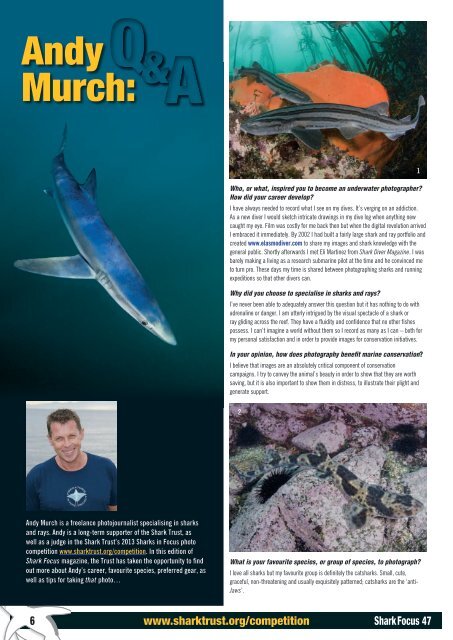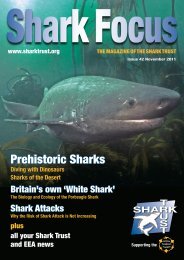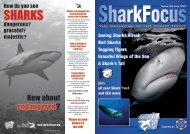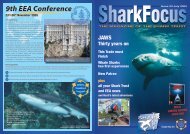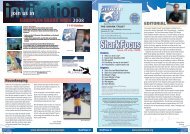Shark Focus
No Limits? - The Shark Trust
No Limits? - The Shark Trust
You also want an ePaper? Increase the reach of your titles
YUMPU automatically turns print PDFs into web optimized ePapers that Google loves.
Andy Q &AMurch:…and your most memorable location?South Africa in general, and Cape Town in particular. Nowhere else can you dive withpowerful Great Whites, prehistoric looking Sevengill <strong>Shark</strong>s, houndsharks and five or sixspecies of catsharks all in the same day!Which species has been the most challenging to photograph?Hammerheads are always a challenge because they are extremely shy around divers. Tophotograph a tiny hammer species called a Scoophead <strong>Shark</strong>, I spent days on an artisanalfishing boat in the Darien jungle (Central America) and then paid the fishermen for a sharkthat came up in their nets so that I could release it and take some shots before it swamaway. Sometimes this is the only way to get images of an endangered species.Are there any locations to which you have returned and noticeddistinct changes (good or bad) in shark populations?Over the last two decades I’ve noticed far fewer reef sharks in the Caribbean but thesame number (if not greater) in the Bahamas. This clearly illustrates how a regional sharkfishing ban can effectively turn the tide on declining shark populations. Globally, I see farmore sharks with broken jaws, hook scars or steel leaders trailing from their mouths.During the course of your work, are there any species or populationswhich stand out as being under particular threat?Hammerheads seem to be having a particularly tough time. Scalloped Hammerheadsschool around many oceanic islands so they are easy targets for longliners. Hopefullytheir recent inclusion in CITES Appendix II will stop some longliners from targeting thembut their future is still far from certain.Have you photographed any elasmobranch species which havedisplayed highly unusual behaviour or characteristics?I once had a mako shark swim up to me and vibrate his open jaws at my camera. Hedidn’t try to bite me or my gear, it was a perfect threat display that said “I am obviouslythe superior animal so I suggest you leave and then I won’t have to show you whatthese things can do”Who, or what, inspired you to become an underwater photographer?How did your career develop?I have always needed to record what I see on my dives. It’s verging on an addiction.As a new diver I would sketch intricate drawings in my dive log when anything newcaught my eye. Film was costly for me back then but when the digital revolution arrivedI embraced it immediately. By 2002 I had built a fairly large shark and ray portfolio andcreated www.elasmodiver.com to share my images and shark knowledge with thegeneral public. Shortly afterwards I met Eli Martinez from <strong>Shark</strong> Diver Magazine. I wasbarely making a living as a research submarine pilot at the time and he convinced meto turn pro. These days my time is shared between photographing sharks and runningexpeditions so that other divers can.13Why did you choose to specialise in sharks and rays?I’ve never been able to adequately answer this question but it has nothing to do withadrenaline or danger. I am utterly intrigued by the visual spectacle of a shark orray gliding across the reef. They have a fluidity and confidence that no other fishespossess. I can’t imagine a world without them so I record as many as I can – both formy personal satisfaction and in order to provide images for conservation initiatives.In your opinion, how does photography benefit marine conservation?I believe that images are an absolutely critical component of conservationcampaigns. I try to convey the animal’s beauty in order to show that they are worthsaving, but it is also important to show them in distress, to illustrate their plight andgenerate support.2What are the most challenging conditions to work in, and why?Lately it seems that I’m either dealing with the physiological challenges of shooting atextreme depth or trying to shoot shark species in coffee-coloured inshore water. Trimixcan help with the narcosis but nothing can help with bad viz. Unfortunately, in the 21 stcentury, the real challenge is finding any sharks left to shoot.Have you ever had a photography ‘disaster’?I’ve had a couple of catastrophic camera floods but so far I’ve been very lucky in findingthe sharks that I have gone looking for and coming home with the shot.Which elusive shark, skate, ray or chimaera sits at the top of your‘hit-list’ of species you haven’t yet photographed?There are quite a few! I would love to shoot a Longfin Mako but perhaps the mostpressing one for me is the Daggernose <strong>Shark</strong> from Brazil. In one decade it has gonefrom locally abundant to Critically Endangered. If we don’t focus on that one soon therewon’t be any left to protect.4Andy Murch is a freelance photojournalist specialising in sharksand rays. Andy is a long-term supporter of the <strong>Shark</strong> Trust, aswell as a judge in the <strong>Shark</strong> Trust’s 2013 <strong>Shark</strong>s in <strong>Focus</strong> photocompetition www.sharktrust.org/competition. In this edition of<strong>Shark</strong> <strong>Focus</strong> magazine, the Trust has taken the opportunity to findout more about Andy’s career, favourite species, preferred gear, aswell as tips for taking that photo…What is your favourite species, or group of species, to photograph?I love all sharks but my favourite group is definitely the catsharks. Small, cute,graceful, non-threatening and usually exquisitely patterned; catsharks are the ‘anti-Jaws’.Can you provide three tips for getting a great shot of a shark, skate,ray or chimaera?Give yourself enough time in the water to make mistakes and learn from them and stillget the shot. Use a very wide lens even for smaller species and get as close as youpossibly can. Try to get some eye contact in the shot. It will draw in your viewers.What is the biggest ‘no-no’, hindrance or mistake in marine photography?Firstly, don’t touch the marine life! Also, bait is a controversial but sometimes necessarycomponent of shark photography. Try to avoid images where the animals are actuallyfeeding. It is much more effective to show sharks and other marine life in a natural state.What is your preferred equipment?My work is tough on gear so I mostly use lower-end DSLRs and treat them assomewhat ‘disposable’. Right now I’m using a Nikon D7000 in a robust Aquaticahousing. The Tokina 10-17 is a great go-to lens for wide-angle shark work. I also carry aSigma 17-70 for shooting smaller subjects. I like to shoot over/unders so I carry a big domeport for that purpose but I also bring along a 4” dome which is better for free diving with.It’s also handy to have that back up dome in case a shark scuffs my larger one.Andy Murch is the CEO and Expedition Leader at Big Fish Expeditions and the founderand driving force behind Predators in Peril – a project recognising the need topublicise the fragile position of many lesser known sharks. With around 300 species ofsharks yet to be recorded, Andy spends his free time tracking down endangered sharkswhich have not yet been photographed. Some of the conservation organisations thathave utilised Andy’s images include: WWF, IUCN, <strong>Shark</strong> Alliance, Ocean Conservancy,<strong>Shark</strong> Trust, Smithsonian, Pew Institute and many other NGOs and government bodies.Find out more about Andy’s work and expeditions:Big Fish Expeditions www.bigfishexpeditions.comElasmodiver <strong>Shark</strong> and Ray Picture Database www.elasmodiver.comPredators in Peril Project www.PredatorsInPeril.orgMain image: Blue <strong>Shark</strong> Prionace glauca © Andy Murch.Image 1: Pyjama Catshark Poroderma africanum © Andy Murch.Image 2: Redspotted Catshark Schroederichthys chilensis © Andy Murch.Image 3: Scoophead <strong>Shark</strong> Sphyrna media © Andy Murch.Image 4: Puffadder Shyshark Haploblepharus edwardsii © Andy Murch.6 www.sharktrust.org/competition <strong>Shark</strong> <strong>Focus</strong> 47<strong>Shark</strong> <strong>Focus</strong> 47 www.sharktrust.org/competition 7


